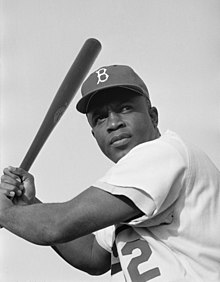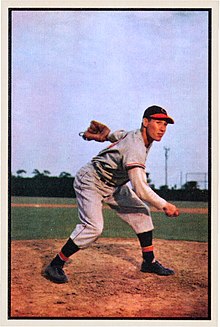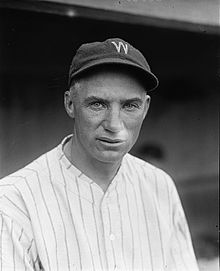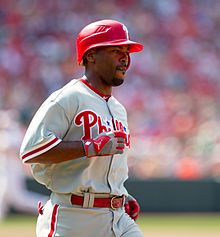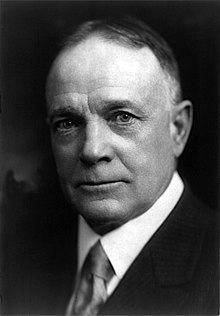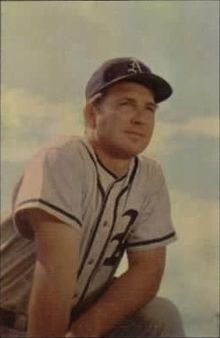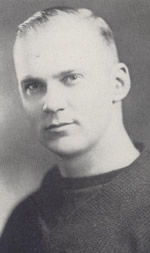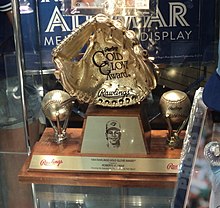Portal:Baseball
Portal maintenance status: (June 2018)
|
| Main page | Content, Categories & Topics | WikiProjects & Things you can do |
The Baseball Portal
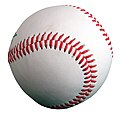
Baseball is a bat-and-ball sport played between two teams of nine players each, taking turns batting and fielding. The game occurs over the course of several plays, with each play generally beginning when a player on the fielding team, called the pitcher, throws a ball that a player on the batting team, called the batter, tries to hit with a bat. The objective of the offensive team (batting team) is to hit the ball into the field of play, away from the other team's players, allowing its players to run the bases, having them advance counter-clockwise around four bases to score what are called "runs". The objective of the defensive team (referred to as the fielding team) is to prevent batters from becoming runners, and to prevent runners advancing around the bases. A run is scored when a runner legally advances around the bases in order and touches home plate (the place where the player started as a batter).
The opposing teams switch back and forth between batting and fielding; the batting team's turn to bat is over once the fielding team records three outs. One turn batting for each team constitutes an inning. A game is usually composed of nine innings, and the team with the greater number of runs at the end of the game wins. Most games end after the ninth inning, but if scores are tied at that point, extra innings are usually played. Baseball has no game clock, though some competitions feature pace-of-play regulations such as the pitch clock to shorten game time.
Baseball evolved from older bat-and-ball games already being played in England by the mid-18th century. This game was brought by immigrants to North America, where the modern version developed. Baseball's American origins, as well as its reputation as a source of escapism during troubled points in American history such as the American Civil War and the Great Depression, have led the sport to receive the moniker of "America's Pastime"; since the late 19th century, it has been unofficially recognized as the national sport of the United States, though in modern times is considered less popular than other sports, such as American football. In addition to North America, baseball spread throughout the rest of the Americas and the Asia–Pacific in the 19th and 20th centuries, and is now considered the most popular sport in parts of Central and South America, the Caribbean, and East Asia, particularly in Japan, South Korea, and Taiwan. (Full article...)
 Featured articles - load new batch
Featured articles - load new batch
-
Image 1

KARE (channel 11) is a television station licensed to Minneapolis, Minnesota, United States, serving as the NBC affiliate for the Twin Cities area. Owned by Tegna Inc., the station maintains studios on Olson Memorial Highway (MN 55) in Golden Valley and a transmitter at the Telefarm site in Shoreview, Minnesota.
Channel 11 began broadcasting on September 1, 1953. It was originally shared by WMIN-TV in St. Paul and WTCN-TV in Minneapolis; the two stations shared an affiliation with ABC and alternated presenting local programs. In 1955, Consolidated Television and Radio bought both stations and merged them as WTCN-TV from the Minneapolis studios in the Calhoun Beach Hotel. The station presented several regionally and nationally notable children's shows in its early years as well as local cooking, news, and sports programs. Time Inc. purchased the station in 1957. Under its ownership, ABC switched its affiliation to KMSP-TV (channel 9), leaving channel 11 to become an independent station that broadcast games of the Minnesota Twins baseball team, movies, and syndicated programs. This continued under two successive owners: Chris-Craft Industries and Metromedia. By the late 1970s, WTCN was one of the nation's most financially successful independent stations. (Full article...) -
Image 2
James Francis Thorpe (Meskwaki: Wa-Tho-Huk, translated as "Bright Path"; May 22 or 28, 1887 – March 28, 1953) was an American athlete and Olympic gold medalist. A member of the Sac and Fox Nation, Thorpe was the first Native American to win a gold medal for the United States in the Olympics. Considered one of the most versatile athletes of modern sports, he won two Olympic gold medals in the 1912 Summer Olympics (one in classic pentathlon and the other in decathlon). He also played football (collegiate and professional), professional baseball, and professional basketball.
He lost his Olympic titles after it was found he had been paid for playing two seasons of semi-professional baseball before competing in the Olympics, thus violating the contemporary amateurism rules. In 1983, 30 years after his death, the International Olympic Committee (IOC) restored his Olympic medals with replicas, after ruling that the decision to strip him of his medals fell outside of the required 30 days. Official IOC records still listed Thorpe as co-champion in decathlon and pentathlon until 2022, when it was decided to restore him as the sole champion in both events. (Full article...) -
Image 3
George Herman "Babe" Ruth (February 6, 1895 – August 16, 1948) was an American professional baseball player whose career in Major League Baseball (MLB) spanned 22 seasons, from 1914 through 1935. Nicknamed "the Bambino" and "the Sultan of Swat", he began his MLB career as a star left-handed pitcher for the Boston Red Sox, but achieved his greatest fame as a slugging outfielder for the New York Yankees. Ruth is regarded as one of the greatest sports heroes in American culture and is considered by many to be the greatest baseball player of all time. In 1936, Ruth was elected to the Baseball Hall of Fame as one of its "first five" inaugural members.
At age seven, Ruth was sent to St. Mary's Industrial School for Boys, a reformatory where he was mentored by Brother Matthias Boutlier of the Xaverian Brothers, the school's disciplinarian and a capable baseball player. In 1914, Ruth was signed to play Minor League baseball for the Baltimore Orioles but was soon sold to the Red Sox. By 1916, he had built a reputation as an outstanding pitcher who sometimes hit long home runs, a feat unusual for any player in the dead-ball era. Although Ruth twice won 23 games in a season as a pitcher and was a member of three World Series championship teams with the Red Sox, he wanted to play every day and was allowed to convert to an outfielder. With regular playing time, he broke the MLB single-season home run record in 1919 with 29. (Full article...) -
Image 4
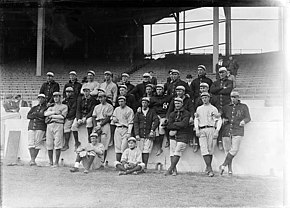
The 1913 squad, the first that went by the name "Yankees"
The history of the New York Yankees Major League Baseball (MLB) team spans more than a century. Frank J. Farrell and William Stephen Devery bought the rights to an American League (AL) club in New York City after the 1902 season. The team, which became known as the Yankees in 1913, rarely contended for the AL championship before the acquisition of outfielder Babe Ruth after the 1919 season. With Ruth in the lineup, the Yankees won their first AL title in 1921, followed by their first World Series championship in 1923. Ruth and first baseman Lou Gehrig were part of the team's Murderers' Row lineup, which led the Yankees to a then-AL record 110 wins and a Series championship in 1927 under Miller Huggins. They repeated as World Series winners in 1928, and their next title came under manager Joe McCarthy in 1932.
The Yankees won the World Series every year from 1936 to 1939 with a team that featured Gehrig and outfielder Joe DiMaggio, who recorded a record hitting streak during New York's 1941 championship season. New York set a major league record by winning five consecutive championships from 1949 to 1953, and appeared in the World Series nine times from 1955 to 1964. Mickey Mantle, Yogi Berra, and Whitey Ford were among the players fielded by the Yankees during the era. After the 1964 season, a lack of effective replacements for aging players caused the franchise to decline on the field, and the team became a money-loser for owners CBS while playing in an aging stadium. (Full article...) -
Image 5
Jack Roosevelt Robinson (January 31, 1919 – October 24, 1972) was an American professional baseball player who became the first African-American to play in Major League Baseball (MLB) in the modern era. Robinson broke the color line when he started at first base for the Brooklyn Dodgers on April 15, 1947. The Dodgers signing Robinson heralded the end of racial segregation in professional baseball, which had relegated black players to the Negro leagues since the 1880s.
Born in Cairo, Georgia, Robinson was raised in Pasadena, California. A four-sport student athlete at Pasadena Junior College and the University of California, Los Angeles, he was better known for football than he was for baseball, becoming a star college player with the UCLA Bruins football team. Following his college career, Robinson was drafted for service during World War II but was court-martialed for refusing to sit at the back of a segregated Army bus, eventually being honorably discharged. Afterwards, he signed with the Kansas City Monarchs of the Negro leagues, where he caught the eye of Branch Rickey, general manager of the Brooklyn Dodgers, who thought he would be the perfect candidate for breaking the color line in MLB. (Full article...) -
Image 6

WSNS-TV (channel 44) is a television station in Chicago, Illinois, United States, serving as the local outlet for the Spanish-language network Telemundo. It is owned and operated by NBCUniversal's Telemundo Station Group alongside NBC outlet WMAQ-TV (channel 5). The two stations share studios at the NBC Tower on North Columbus Drive in the city's Streeterville neighborhood and broadcast from the same transmitter atop the Willis Tower in the Chicago Loop.
WSNS-TV began broadcasting in 1970. Originally specializing in the automated display of news headlines, it evolved into Chicago's third full-fledged independent station, carrying movies, local sports, and other specialty programming. This continued until 1980, when WSNS became the Chicago-area station for ON TV, an over-the-air subscription television (STV) service owned by Oak Industries, which took a minority ownership stake in the station. While ON TV was successful in Chicago and the subscription system became the second-largest in the country by total subscribers, the rise of cable television precipitated the end of the business in 1985, with WSNS-TV as the last ON TV station standing. (Full article...) -
Image 7
A picture of a Wii Sports disc
Wii Sports is a 2006 sports simulation video game developed and published by Nintendo for the Wii video game console. The game was released in North America along with the Wii on November 19, 2006, and in Japan, Australia, and Europe the following month. It was included as a pack-in game with the console in all territories except Japan, making it the first sports game included with the launch of a Nintendo system since Mario's Tennis for the Virtual Boy in 1995. The game was later released on its own as part of the Nintendo Selects collection of games.
Wii Sports is a collection of five sports simulations designed to demonstrate the motion-sensing capabilities of the Wii Remote. The five sports included are tennis, baseball, bowling, golf, and boxing. Players use the Wii Remote to mimic actions performed in real-life sports, such as swinging a tennis racket or rolling a bowling ball. The rules for each game are simplified to make them more accessible to new players. The game also features training and fitness modes that monitor players' progress in the sports. (Full article...) -
Image 8Advertisement in Billboard magazine in 1907
How Brown Saw the Baseball Game is an American short silent comedy film produced in 1907 and distributed by the Lubin Manufacturing Company. The film follows a baseball fan named Mr. Brown who overdrinks before a baseball game and becomes so intoxicated that the game appears to him in reverse motion. During production, trick photography was used to achieve this effect. The film was released in November 1907. It received a positive review in a 1908 issue of The Courier-Journal that reported the film was successful and "truly funny". As of 2021[update], it is unclear whether the print of the film has survived. The identities of the film cast and production crew are unknown. Film historians have noted similarities between the plot of How Brown Saw the Baseball Game and How the Office Boy Saw the Ball Game. It is a comedy film directed by Edwin S. Porter, having released a year before How Brown Saw the Baseball Game. (Full article...) -
Image 9
Herschel Greer Stadium was a Minor League Baseball park in Nashville, Tennessee, on the grounds of Fort Negley, an American Civil War fortification, approximately two mi (3.2 km) south of the city's downtown district. The facility closed at the end of the 2014 baseball season and remained deserted for over four years until its demolition in 2019. Following an archaeological survey, the land is expected to be reincorporated into Fort Negley Park.
Greer was opened in 1978 for the Nashville Sounds, an expansion franchise of the Double-A Southern League who moved to the Triple-A American Association in 1985 and to the Triple-A Pacific Coast League in 1998. The stadium played host to the team until 2014. The subject of numerous upgrades and repairs to maintain its functionality, Greer became one of the oldest stadiums used by a Triple-A team and had fallen well below professional baseball's standards for a stadium at that class level by the end of its use. For over a decade, the Sounds attempted to secure agreements with the Metropolitan Government of Nashville and Davidson County for a new ballpark to replace Greer, eventually resulting in the construction of First Tennessee Park, which became the Sounds' new home in 2015. (Full article...) -
Image 10
Charles Dillon "Casey" Stengel (/ˈstɛŋɡəl/; July 30, 1890 – September 29, 1975) was an American Major League Baseball right fielder and manager, best known as the manager of the championship New York Yankees of the 1950s and later, the expansion New York Mets. Nicknamed "the Ol' Perfessor", he was elected to the Baseball Hall of Fame in 1966.
Stengel was born in Kansas City, Missouri, in 1890. In 1910, he began a professional baseball career that would span over half a century. After almost three seasons in the minor leagues, Stengel reached the major leagues late in 1912, as an outfielder, for the Brooklyn Dodgers. His six seasons there saw some success, among them playing for Brooklyn's 1916 National League championship team, but he also developed a reputation as a clown. After repeated clashes over pay with the Dodgers owner, Charlie Ebbets, Stengel was traded to the Pittsburgh Pirates in 1918; however, he enlisted in the Navy that summer, for the remainder of World War I. After returning to baseball, he continued his pay disputes, resulting in trades to the Philadelphia Phillies (in 1919) and to the New York Giants (in 1921). There, he learned much about baseball from the manager, John McGraw, and had a number of highlights in his career, including hitting an inside-the-park home run in Game 1 of the 1923 World Series to defeat the Yankees. His major league playing career ended with the Boston Braves in 1925, but he then began a career as a manager. (Full article...) -
Image 11
Robert William Andrew Feller (November 3, 1918 – December 15, 2010), nicknamed "the Heater from Van Meter", "Bullet Bob", and "Rapid Robert", was an American baseball pitcher who played 18 seasons in Major League Baseball (MLB) for the Cleveland Indians between 1936 and 1956. In a career spanning 570 games, Feller pitched 3,827 innings and posted a win–loss record of 266–162, with 279 complete games, 44 shutouts, and a 3.25 earned run average (ERA). His career 2,581 strikeouts were third all-time upon his retirement.
A prodigy who bypassed baseball's minor leagues, Feller made his debut with the Indians at the age of 17. His career was interrupted by four years of military service (1942–1945) as a United States Navy Chief Petty Officer aboard USS Alabama during World War II. Feller became the first pitcher to win 24 games in a season before the age of 21. He threw no-hitters in 1940, 1946, and 1951, and 12 one-hitters, both records at his retirement. He helped the Indians win a World Series title in 1948 and an American League-record 111 wins and the pennant in 1954. Feller led the American League in wins six times and in strikeouts seven times. In 1946 he recorded 348 strikeouts, the most since 1904 and then believed to be a record. (Full article...) -
Image 12
Arthur Joseph Houtteman (August 7, 1927 – May 6, 2003) was an American right-handed pitcher in Major League Baseball who played for 12 seasons in the American League with the Detroit Tigers, Cleveland Indians and Baltimore Orioles. In 325 career games, Houtteman pitched 1,555 innings and posted a win–loss record of 87–91, with 78 complete games, 14 shutouts, and a 4.14 earned run average (ERA).
Known on the sandlot for his pitching motion, Houtteman was signed by scout Wish Egan in 1945 at 17 years of age. He was recruited by major league teams, and joined a Tigers pitching staff that had lost players to injuries and World War II. After moving between the major and minor leagues over the next few years, he was nearly killed in an automobile accident just before the 1949 season. Houtteman rebounded from his injuries and went on to win 15 games that season and made his only All-Star appearance in the following year. (Full article...) -
Image 13
Stanley Anthony Coveleski (born Stanislaus Kowalewski, July 13, 1889 – March 20, 1984) was an American right-handed pitcher in Major League Baseball who played for four American League (AL) teams between 1912 and 1928, primarily the Cleveland Indians. The star of the Indians pitching staff, he won over 20 games each year from the war-shortened 1918 season through 1921, leading the AL in shutouts twice and in strikeouts and earned run average (ERA) once each during his nine years with the club. The star of the 1920 World Series, he led the Indians to their first title with three complete-game victories, including a 3–0 shutout in the Game 7 finale. Traded to the Washington Senators after the 1924 season, he helped that club to its second AL pennant in a row with 20 victories against only 5 losses, including a 13-game winning streak, while again leading the league in ERA.
Coveleski followed in the footsteps of his brother Harry as a major league pitcher. But after making his debut with the Philadelphia Athletics in 1912, he was sidetracked by three more seasons in the minor leagues before joining the Indians in 1916, and won only 13 major league games before turning 27. Coveleski specialized in throwing the spitball, where the pitcher alters the ball with a foreign substance such as chewing tobacco. It was legal when his career began but prohibited in 1920, with Coveleski being one of 17 pitchers permitted to continue throwing the pitch. In 450 career games, Coveleski pitched 3,082 innings and posted a record of 215–142, with 224 complete games, 38 shutouts, and a 2.89 ERA. He set Cleveland records of 172 wins, 2,502+1⁄3 innings and 305 starts, which were later broken by Mel Harder and Willis Hudlin. He was inducted into the Baseball Hall of Fame in 1969. (Full article...) -
Image 14The 2004 World Series was the championship series of Major League Baseball's (MLB) 2004 season. The 100th edition of the World Series, it was a best-of-seven playoff between the American League (AL) champion Boston Red Sox and the National League (NL) champion St. Louis Cardinals; the Red Sox swept the Cardinals in four games. The series was played from October 23 to 27, 2004, at Fenway Park and Busch Memorial Stadium, broadcast on Fox, and watched by an average of just under 25.5 million viewers. The Red Sox's World Series championship was their first since 1918, ending the Curse of the Bambino.
The Cardinals earned their berth into the playoffs by winning the NL Central division title, and had the best win–loss record in the NL. The Red Sox won the AL wild card to earn theirs. The Cardinals reached the World Series by defeating the Los Angeles Dodgers in the best-of-five NL Division Series and the Houston Astros in the best-of-seven NL Championship Series. The Red Sox defeated the Anaheim Angels in the AL Division Series. After trailing three games to none to the New York Yankees in the AL Championship Series, the Red Sox came back to win the series, advancing to their first World Series since 1986. The Cardinals made their first appearance in the World Series since 1987. With the New England Patriots winning Super Bowl XXXVIII, the World Series victory made Boston the first city to have Super Bowl and World Series championship teams in the same year (2004) since Pittsburgh in 1979. The Red Sox became the third straight wild card team to win the World Series; the Anaheim Angels won in 2002 and the Florida Marlins won in 2003. (Full article...) -
Image 15Los Angeles Angels center fielder Mike Trout hits a home run on a pitch from New York Mets pitcher Tommy Milone on May 21, 2017.
Baseball is a bat-and-ball sport played between two teams of nine players each, taking turns batting and fielding. The game occurs over the course of several plays, with each play generally beginning when a player on the fielding team, called the pitcher, throws a ball that a player on the batting team, called the batter, tries to hit with a bat. The objective of the offensive team (batting team) is to hit the ball into the field of play, away from the other team's players, allowing its players to run the bases, having them advance counter-clockwise around four bases to score what are called "runs". The objective of the defensive team (referred to as the fielding team) is to prevent batters from becoming runners, and to prevent runners advancing around the bases. A run is scored when a runner legally advances around the bases in order and touches home plate (the place where the player started as a batter).
The initial objective of the batting team is to have a player reach first base safely; this generally occurs either when the batter hits the ball and reaches first base before an opponent retrieves the ball and touches the base, or when the pitcher persists in throwing the ball out of the batter's reach. Players on the batting team who reach first base without being called "out" can attempt to advance to subsequent bases as a runner, either immediately or during teammates' turns batting. The fielding team tries to prevent runs by using the ball to get batters or runners "out", which forces them out of the field of play. The pitcher can get the batter out by throwing three pitches which result in strikes, while fielders can get the batter out by catching a batted ball before it touches the ground, and can get a runner out by tagging them with the ball while the runner is not touching a base. (Full article...)
General images - load new batch
-
Image 11906 World Series, infielders playing "in" for the expected bunt and the possible play at the plate with the bases loaded (from Baseball rules)
-
Image 3Cy Young—the holder of many major league career marks, including wins and innings pitched, as well as losses—in 1908. MLB's annual awards for the best pitcher in each league are named for Young. (from Baseball)
-
Image 4Pick-off attempt on runner (in red) at first base (from Baseball rules)
-
Image 5The NL champion New York Giants baseball team, 1913. Fred Merkle, sixth in line, had committed a baserunning gaffe in a crucial 1908 game that became famous as Merkle's Boner. (from History of baseball)
-
Image 6The American Tobacco Company's line of baseball cards featured shortstop Honus Wagner of the Pittsburgh Pirates from 1909 to 1911. In 2007, the card shown here sold for $2.8 million. (from Baseball)
-
Image 7A first baseman receives a pickoff throw, as the runner dives back to first base. (from Baseball)
-
Image 8Pesäpallo, a Finnish variation of baseball, was invented by Lauri "Tahko" Pihkala in the 1920s, and after that, it has changed with the times and grown in popularity. Picture of Pesäpallo match in 1958 in Jyväskylä, Finland. (from Baseball)
-
Image 9Pitchers are generally substituted during mound visits (team gatherings at the pitcher's mound). (from Baseball rules)
-
Image 11Jackie Robinson in 1945, with the era's Kansas City Royals, a barnstorming squad associated with the Negro American League's Kansas City Monarchs (from History of baseball)
-
Image 12A pitcher handing off the ball after being taken out of the game during a mound meeting. (from Baseball)
-
Image 13A runner sliding into home plate and scoring. (from Baseball)
-
Image 14Baserunners generally stand a short distance away from their base between pitches, preparing themselves to either go back or steal the next base. (from Baseball rules)
-
Image 15Japanese-Americans spectating a World War II-era game while in an internment camp. America's ties to immigrants and to Japan have been deeply shaped by a shared baseball heritage. (from History of baseball)
-
Image 16The typical motion of a right-handed pitcher (from Baseball rules)
-
Image 17Alexander Cartwright, father of modern baseball (from History of baseball)
-
Image 19Fenway Park, home of the Boston Red Sox. The Green Monster is visible beyond the playing field on the left. (from Baseball)
-
Image 20Diagram of a baseball field Diamond may refer to the square area defined by the four bases or to the entire playing field. The dimensions given are for professional and professional-style games. Children often play on smaller fields. (from Baseball)
-
Image 21An Afghan girl playing baseball in August 2002 (from Baseball)
-
Image 22Cover of Official Base Ball Rules, 1921 edition, used by the American League and National League (from Baseball rules)
-
Image 23Jackie Robinson in 1945, with the era's Kansas City Royals, a barnstorming squad associated with the Negro American League's Kansas City Monarchs (from Baseball)
-
Image 24A batter follows through after swinging at a pitched ball. (from Baseball rules)
-
Image 26Sadaharu Oh managing the Japan national team in the 2006 World Baseball Classic. Playing for the Central League's Yomiuri Giants (1959–80), Oh set the professional world record for home runs. (from Baseball)
-
Image 27The strike zone determines the result of most pitches, and varies in vertical length for each batter. (from Baseball)
-
Image 28Defensive positions on a baseball field, with abbreviations and scorekeeper's position numbers (not uniform numbers) (from Baseball)
-
Image 30The strike zone, which determines the outcome of most pitches, varies in vertical length depending on the batter's typical height while swinging. (from Baseball rules)
-
Image 32A New York Yankees batter (Andruw Jones) and a Boston Red Sox catcher at Fenway Park (from Baseball)
-
Image 33Baseball games sometimes end in a walk-off home run, with the batting team usually gathering at home plate to celebrate the scoring of the winning run(s). (from Baseball rules)
-
Image 34The standard fielding positions (from Baseball rules)
-
Image 36A well-worn baseball (from Baseball)
-
Image 37Rickey Henderson—the major leagues' all-time leader in runs and stolen bases—stealing third base in a 1988 game (from Baseball)
-
Image 39In May 2010, the Philadelphia Phillies' Roy Halladay pitched the 20th major league perfect game. That October, he pitched only the second no-hitter in MLB postseason history. (from History of baseball)
-
Image 40Sadaharu Oh managing the Japan national team in the 2006 World Baseball Classic. Playing for the Central League's Yomiuri Giants (1959–80), Oh set the professional world record for home runs with 868. (from History of baseball)
-
Image 422013 World Baseball Classic championship match between the Dominican Republic and Puerto Rico, March 20, 2013 (from Baseball)
-
Image 43A game from the Cantigas de Santa Maria, c. 1280, involving tossing a ball, hitting it with a stick and competing with others to catch it (from History of baseball)
-
Image 44Two players on the baseball team of Tokyo, Japan's Waseda University in 1921 (from Baseball)
-
Image 45By the 1860s Civil War, baseball (bottom) had overtaken its fellow bat-and-ball sport cricket (top) in popularity within the United States. (from History of baseball)
 Good articles - load new batch
Good articles - load new batch
-
Image 1
James Calvin Rollins (born November 27, 1978), nicknamed "J-Roll", is an American former professional baseball shortstop, who played in Major League Baseball (MLB) for the Philadelphia Phillies (2000–2014), Los Angeles Dodgers (2015), and Chicago White Sox (2016).
After growing up in Alameda, California, and attending Encinal High School, Rollins was drafted by the Phillies in the second round of the 1996 MLB draft. After spending most of five seasons with Phillies minor league teams, he made his big league debut on September 17, 2000. (Full article...) -
Image 2
John Frederick Hiller (born April 8, 1943) is a Canadian former baseball relief pitcher who played 15 seasons in Major League Baseball (MLB) for the Detroit Tigers between 1965 and 1980. A native of Toronto, he joined the Tigers in 1965 and was a member of the 1968 Detroit Tigers team that won the World Series. He set a major league record by starting a game with six consecutive strikeouts in 1968.
In January 1971, Hiller suffered a heart attack and underwent intestinal surgery to control his body's absorption of cholesterol. After missing the 1971 season, Hiller returned in 1972, helping the Tigers win the American League (AL) East title and winning Game 4 of the 1972 AL Championship Series. In 1973, he compiled a 1.44 earned run average (ERA) and broke the major league single-season saves record with 38. The Sporting News awarded Hiller its 1973 Comeback Player of the Year and Fireman of the Year awards. (Full article...) -
Image 3

Thomas Virgil Sturdivant (April 28, 1930 – February 28, 2009), nicknamed "Snake", was an American pitcher who played for the New York Yankees, Kansas City Athletics, Boston Red Sox, Washington Senators, Pittsburgh Pirates, Detroit Tigers, and New York Mets of Major League Baseball. He threw a curveball and a knuckleball, among other pitches. He batted left-handed but threw right-handed.
Sturdivant was originally signed by the Yankees as an infielder in 1948. After a two-year stint in the United States Army, he became a pitcher in order to improve his chances of making the major leagues. He debuted with the Yankees in 1955, the first of four straight years he was on a World Series roster. In 1956, he had a 16–8 record, led the American League (AL) with a 2.12 strikeout-to-walk ratio, and won Game 4 of the 1956 World Series, which the Yankees won in seven games over the Brooklyn Dodgers. He went 16–6 in 1957, tying for the AL lead in winning percentage with a .727 mark. Arm trouble and a spike wound to the heel limited him in 1958, though he won his second World Series as the Yankees defeated the Milwaukee Braves in seven games. (Full article...) -
Image 4
Mark Hodge Murphy (born July 13, 1955) is an American football executive and former player who is the president and chief executive officer (CEO) for the Green Bay Packers of the National Football League (NFL). Murphy, a safety, went undrafted in the 1977 NFL draft after playing college football at Colgate University. He was signed by the Washington Redskins, where he played for eight seasons from 1977 to 1984. With the Redskins, Murphy won Super Bowl XVII, played in Super Bowl XVIII and led the NFL in interceptions in 1983, earning his sole Pro Bowl and All-Pro honor that season.Mark Murphy 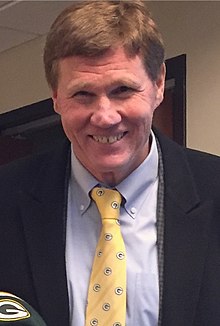 Murphy in 2016
Murphy in 2016Green Bay Packers Position: President and CEO Personal information Born: (1955-07-13) July 13, 1955 (age 69)
Fulton, New York, U.S.Height: 6 ft 4 in (1.93 m) Weight: 210 lb (95 kg) Career information High school: Clarence (Clarence, New York) College: Colgate Undrafted: 1977 Career history As a player: As an executive: - *
- Colgate (1992–2003)
- Athletic director
*- Northwestern (2003–2007)
- Athletic director
- Green Bay Packers (2007–present)
- President and CEO
Career highlights and awards As a player:* Super Bowl champion (XVII)* First-team All-Pro (1983)* Pro Bowl (1983)* NFL Interceptions leader (1983)* 90 Greatest RedskinsAs an executive:* Super Bowl champion (XLV) Career NFL statistics Games played: 109 Interceptions (INT): 27 INT return yards: 282 Stats at Pro Football Reference
Murphy received a Master of Business Administration from American University near the end of his career before retiring in 1984 and earning a Juris Doctor degree from Georgetown University in 1988. After his playing career, he worked for the NFL Players Association (NFLPA) and then as a trial lawyer for the United States Department of Justice. In 1992, he was hired as the athletic director of his alma mater Colgate University. In 2003, he moved to Northwestern University to serve as their athletic director, a position he held until 2007. (Full article...) -
Image 5
Matthew Ryan Kemp (born September 23, 1984) is an American former professional baseball outfielder. He began his professional career in the Los Angeles Dodgers organization in 2003, and played in Major League Baseball (MLB) with the Dodgers from 2006 until 2014, the San Diego Padres in 2015 and 2016 and the Atlanta Braves in 2016 and 2017 before returning to the Dodgers for the 2018 season, and briefly playing for the Cincinnati Reds in 2019 and Colorado Rockies in 2020. He was named to three All-Star teams and won two Gold Glove Awards (2009 and 2011) and two Silver Slugger Awards (2009 and 2011).
The Dodgers selected Kemp in the sixth round of the 2003 MLB draft. After four seasons in the minor leagues, he made his major league debut in 2006. He did not become a full-time player until 2008, when he took over as the starting center fielder for the Dodgers. In 2011, Kemp led the National League in runs scored (115), total bases (353), OPS+ (171), WAR (7.8), home runs (39), and runs batted in (126). Additionally, he became the first player to finish in the top two in both home runs and steals since Hank Aaron in 1963. (Full article...) -
Image 6Shawn Patrick Sedlacek [sed′–la–check] (born June 29, 1977) is an American former professional baseball pitcher. He played part of one season in Major League Baseball (MLB), primarily as a starting pitcher, for the Kansas City Royals in 2002. Sedlacek threw a four-seam fastball, a two-seam fastball, a changeup, a slider, and a curveball.
Born in Cedar Rapids, Iowa, Sedlacek attended Iowa State University, leading the team with 65 strikeouts and 77 innings pitched as a senior before getting selected by the Royals in the 1998 MLB draft. Initially expected to be a relief pitcher, he became a starting pitcher during his first season due to injuries to other starters, and he would finish among the leaders in the minor leagues he pitched in over the next few years. The Royals called him up in June 2002 following injuries to Jeremy Affeldt and Paul Byrd, and he debuted for them on June 18. Sedlacek posted a 3.05 earned run average (ERA) in his first six starts but had a 10.10 ERA in his next eight and was moved to the bullpen in September. After pitching for Kansas City's minor league affiliates in 2003, he left the Royals organization and played for two years in the minors for several other teams and also in the independent Northern League. Remaining in the Kansas City area following his retirement, he is part of Complete Game Baseball, an organization that provides baseball training and fields its own teams. (Full article...) -
Image 7
Colbert Michael Hamels (born December 27, 1983), nicknamed "Hollywood", is an American former professional baseball pitcher. He played in Major League Baseball (MLB) for the Philadelphia Phillies (2006–2015), Texas Rangers (2015–2018), Chicago Cubs (2018–2019), and Atlanta Braves (2020).
Originally from San Diego, California, Hamels excelled at Rancho Bernardo High School both academically and athletically. The Phillies drafted Hamels out of high school, in the first round (17th overall) of the 2002 MLB Draft, and he began playing in the Phillies’ minor league system. Numerous issues, including an injury sustained in a bar fight, among other injuries, occurred during Hamels’ first few minor league seasons. When he reached the Triple-A level, he was the top pitcher in the Phillies' minor league system in 2006. (Full article...) -
Image 8
Frank Leroy Chance (September 9, 1877 – September 15, 1924) was an American professional baseball player. A first baseman, Chance played in Major League Baseball for the Chicago Cubs and New York Yankees from 1898 through 1914. He also served as manager of the Cubs, Yankees, and Boston Red Sox.
Discovered by the Cubs as he played semi-professional baseball while attending college, Chance debuted with the Cubs in 1898, serving as a part-time player. In 1903, Chance became the Cubs' regular first baseman, and in 1905, he succeeded Frank Selee as the team's manager. Chance led the Cubs to 100 wins in 1906, 1907, 1909, and 1910, becoming the first manager to compile four 100-win seasons (only eight other managers have accomplished the feat in MLB history), with no manager, other than Chance, leading a team to 100 wins four times in five seasons. They would win four National League championships in that span and won the World Series in 1907 and 1908. With Joe Tinker and Johnny Evers, Chance formed a strong double play combination, which was immortalized as "Tinker-to-Evers-to-Chance" in "Baseball's Sad Lexicon". (Full article...) -
Image 9
William (Billy) Ashley Sunday (November 19, 1862 – November 6, 1935) was an American evangelist and professional baseball outfielder. He played for eight seasons in the National League before becoming the most influential American preacher during the first two decades of the 20th century.
Born into poverty near Ames, Iowa, Sunday spent some years at the Iowa Soldiers' Orphans' Home before working at odd jobs and playing for local running and baseball teams. His speed and agility provided him the opportunity to play baseball in the major leagues for eight years. (Full article...) -
Image 10
Alfred Aloysius "Allie" Clark (June 16, 1923 – April 2, 2012) was an American right fielder in Major League Baseball who played for seven seasons in the American League with the New York Yankees, Cleveland Indians, Philadelphia Athletics and Chicago White Sox. In 358 career games, Clark recorded a batting average of .262 and accumulated 32 home runs and 149 runs batted in (RBIs).
Clark was born in South Amboy, New Jersey, where he attended St. Mary's High School, and joined the New York Yankees organization after graduating. He spent the next six seasons playing minor league baseball and serving in the U.S. Army during World War II. He made his major league debut in 1947, and after one year with the Yankees, he spent four seasons with the Cleveland Indians. He was a member of the World Champion Yankees and Indians after the two teams won the 1947 World Series and 1948 World Series, respectively. He then played with the Philadelphia Athletics and Chicago White Sox through 1953, and played minor league baseball until 1958. After retiring, he returned to South Amboy and resided there until his death in 2012. (Full article...) -
Image 11
Robert Lynn Bomar (January 21, 1901 – June 11, 1964) was an American football end in the National Football League (NFL). Bomar played college football, basketball and baseball for Vanderbilt University, following coach Wallace Wade and classmate Hek Wakefield there from prep school, and was a unanimous 1922 All-Southern selection and a consensus 1923 All-American selection in football. The latter season included a first-team All-American selection by Walter Camp, rare for a player in the South. A paralyzing injury ended Bomar's college career, but he quickly recovered and sat on the bench for all of his team's games. He played for the New York Giants in 1925 and 1926, retiring abruptly after a separate injury. Bomar was nicknamed "the Blonde Bear".
He had a later career in law enforcement. In his position as Tennessee's Commissioner of Public Safety and Patrol chief, Bomar supervised the ransacking of black households during the 1946 Columbia race riot. He was the warden of Tennessee State Prison from 1955 until his death, and oversaw several executions. In 1956, Bomar was the first Vanderbilt football player elected to the College Football Hall of Fame. (Full article...) -
Image 12Thomas Reid Nichols (born August 5, 1958) is an American former outfielder and coach in Major League Baseball (MLB). He played for the Boston Red Sox (1980–1985), Chicago White Sox (1985–1986), and Montreal Expos (1987). Listed at 6 feet 0 inches (1.83 m) and 195 pounds (88 kg), he batted and threw right-handed. After his playing career ended, he served as a coach and minor league coordinator for the Baltimore Orioles, Texas Rangers, and Milwaukee Brewers.
Though he did not watch professional baseball growing up, Nichols started playing Little League Baseball at age 11 and drew interest from the Red Sox and the Los Angeles Dodgers when he graduated high school. The Red Sox selected him in the 12th round (286th overall) of the 1976 MLB draft, and he debuted with them in 1980. Though never an everyday starter, he batted a career-high .302 in 1982 and played a career-high 100 games in 1983. In 1985, he was traded to the White Sox, remaining with them through the 1986 season. Nichols played for the Expos in 1987, spent part of 1988 in the Texas Rangers organization, and joined the Chicago Cubs for 1989 spring training before retiring. (Full article...) -
Image 13"All the Way" (also known as "(Someday We'll Go) All the Way" and referred to as "Go All the Way") is a song written and performed by Evanston, Illinois native and Pearl Jam vocalist Eddie Vedder about the Chicago Cubs. It was first performed in public on August 2, 2007, recorded on August 21, 2008 and August 22, 2008, and released as a single on September 18, 2008.
At the time of the song's release in 2008, it had been 100 years since the Cubs had last won the World Series. Vedder has been a lifelong Cubs fan. The song, which fondly looks forward to the Cubs' next World Series victory, was written with the encouragement of certain Chicago Cubs, most notably Ernie Banks. The song was first performed in Chicago and was recorded over two nights in 2008 at the end Vedder's first solo tour. The song was accompanied by an official video release by the team following their victory in the 2016 World Series. (Full article...) -
Image 14
Lawrence Eugene Doby (December 13, 1923 – June 18, 2003) was an American professional baseball player in the Negro leagues and Major League Baseball (MLB) who was the second black player to break baseball's color barrier and the first black player in the American League. A native of Camden, South Carolina, and three-sport all-state athlete while in high school in Paterson, New Jersey, Doby accepted a basketball scholarship from Long Island University. At 17 years of age, he began his professional baseball career with the Newark Eagles as the team's second baseman. Doby joined the United States Navy during World War II. His military service complete, Doby returned to baseball in 1946, and along with teammate Monte Irvin, helped the Eagles win the Negro League World Series.
In July 1947, three months after Jackie Robinson made history with the Brooklyn Dodgers, Doby broke the color barrier in the American League when he signed a contract to play with Bill Veeck's Cleveland Indians. Doby was the first player to go directly to the majors from the Negro leagues. A seven-time All-Star center fielder, Doby and teammate Satchel Paige were the first African-American players to win a World Series championship when the Indians took the crown in 1948. He helped the Indians win 111 games (second-best in MLB history at the time) and the AL pennant in 1954, finished second in the American League Most Valuable Player (MVP) award voting and was the AL's RBI leader and home run champion. He went on to play for the Chicago White Sox, Detroit Tigers, and Chunichi Dragons before his retirement as a player in 1962. (Full article...) -
Image 15

Robert Alexander Unglaub (July 31, 1880 – November 29, 1916) was an American first baseman, utility infielder and manager in Major League Baseball who played for the New York Highlanders, Boston Americans, and Washington Senators. He batted and threw right-handed. Unglaub stood 5 feet 11 inches (1.80 m) and weighed 178 pounds (81 kg).
A Baltimore native, Unglaub was first exposed to baseball when he served as batboy and mascot for the Baltimore Orioles. He made his major league debut with the Highlanders in 1904 and was traded to Boston later that year. Though he started at first base for Boston in late 1905, he played minor league baseball in 1906 because of a salary dispute. Back with the Americans in 1907, he became their full-time first baseman and even their manager, though the latter role lasted for only 29 games. He was traded to Washington in 1908 and remained with the Senators through the 1910 season. Unglaub then played in the minor leagues for six more years before he was killed in an accident while working at Baltimore's Pennsylvania Railroad shops. (Full article...)
Did you know (auto-generated) - load new batch

- ... that Park "Saebyeolbe" Jong-ryeol was the first esports player to throw a Major League Baseball opening pitch?
- ... that Larry Kennedy played professional baseball while serving as his town's mayor?
- ... that Jenny Cavnar is the first female primary play-by-play announcer in Major League Baseball history?
- ... that Genevieve Beacom became the first woman to pitch in the Australian Baseball League when she made her debut for the Melbourne Aces in 2022?
- ... that Helene Hathaway Britton, the first woman to own a Major League Baseball team, was unsuccessfully pressured by other club owners to sell the team?
- ... that Puerto Rico's Willie Hernández became the highest paid player in Detroit Tigers history after winning Cy Young and Most Valuable Player awards and a World Series?
- ... that Tom Urbani was an original Dirtbag?
- ... that baseball player Nick Solak was named after the sports bar where his parents first met?
Quotes
| Managing can be more discouraging than playing, especially when you're losing because when you're a player, there are at least individual goals you can shoot for. When you're a manager all the worries of the team become your worries. |
 Featured lists - load new batch
Featured lists - load new batch
-
Image 1

Félix Hernández, the 2007 and 2009-2018 Opening Day starter
The Seattle Mariners are a Major League Baseball (MLB) franchise based in Seattle, Washington. They play in the American League West division. The first game of the new baseball season for a team is played on Opening Day, and being named the Opening Day starter is an honor, which is often given to the player who is expected to lead the pitching staff that season, though there are various strategic reasons why a team's best pitcher might not start on Opening Day. The Mariners have used 15 different Opening Day starting pitchers in their 41 seasons. The 15 starters have a combined Opening Day record of 15 wins, 13 losses (15–13) and 13 no decisions. No decisions are only awarded to the starting pitcher if the game is won or lost after the starting pitcher has left the game.
Félix Hernández has the Mariners' record for most Opening Day starts with eleven, recording a record of 7–2. Randy Johnson has the most starts in the former home ballpark of the Mariners, the Kingdome, compiling an Opening Day record of 2–0 in 6 starts. Jamie Moyer has the most starts in Safeco Field, the Mariners' current home ballpark, and has an Opening Day record of 1–2. Mark Langston has the worst winning percentage as the Opening Day starting pitcher with a record of 0–3, all of which were pitched on the road. (Full article...) -
Image 2

In 2019, Mike Trout signed a 12-year, $426 million contract with the Angels, the richest contract in the history of North American sports at the time.
Major League Baseball (MLB) does not have a hard salary cap, instead employing a luxury tax which applies to teams whose total payroll exceeds certain set thresholds for a given season. Free agency did not exist in MLB prior to the end of the reserve clause in the 1970s, allowing owners before that time to wholly dictate the terms of player negotiations and resulting in significantly lower salaries.
Babe Ruth, widely regarded as one of the greatest baseball players ever, earned an estimated $856,850 ($19,515,718 inflation-adjusted from 1934 dollars) over his entire playing career. When asked whether he thought he deserved to earn $80,000 a year ($1,459,124 inflation-adjusted), while the president, Herbert Hoover, had a $75,000 salary, Ruth famously remarked, "What the hell has Hoover got to do with it? Besides, I had a better year than he did." (Full article...) -
Image 3

Alex Cora (waving) is the most recent manager to lead the Red Sox to a World Series championship.
The Boston Red Sox are a professional baseball team based in Boston, Massachusetts. The Red Sox are members of the American League (AL) East Division in Major League Baseball (MLB). They have competed since 1901, initially as the Boston Americans (1901–1907), and under their current name since 1908. Since 1912, the Red Sox have played their home games at Fenway Park. In baseball, the head coach of a team is called the manager, or more formally, the field manager. There have been 48 different managers in franchise history; the current manager is Alex Cora, who previously managed the team during the 2018 and 2019 seasons and was re-hired by the team on November 6, 2020.
Jimmy Collins was the first manager of the franchise, managing from 1901 to 1906. Among all Red Sox managers, Joe Cronin managed the most regular season games (2,007) and registered the most regular season wins (1,071), while Terry Francona managed the most playoff games (45) and registered the most playoff wins (28). The most World Series championships won by a Red Sox manager is two, accomplished by Bill Carrigan (1915 and 1916) and Francona (2004 and 2007). John McNamara and Jimy Williams are the only two Red Sox managers to win the AL Manager of the Year Award, in 1986 and 1999, respectively. (Full article...) -
Image 4

Tim Dillard is the Sounds' career leader in wins (48), games pitched (242), innings pitched (710), and strikeouts (437).
The Nashville Sounds Minor League Baseball team has played in Nashville, Tennessee, since being established in 1978 as an expansion team of the Double-A Southern League. They moved up to Triple-A in 1985 as members of the American Association before joining the Pacific Coast League in 1998. The team was placed in the Triple-A East in 2021 prior to this becoming the International League in 2022. In the history of the franchise, numerous players and teams have set records in various statistical areas during single games, entire seasons, or their Sounds careers.
Of the nine Sounds who hold the 19 career records tracked by the team, Tim Dillard holds the most, with seven. He is followed by Skeeter Barnes and Chad Hermansen, with three each; and Keith Brown, Mark Corey, Hugh Kemp, Otis Nixon, Tike Redman, and Joey Wendle, with one apiece. Dillard holds the most franchise records, with eight. He is followed by Jamie Werly, with six; and Steve Balboni and Skeeter Barnes, who hold four records each. (Full article...) -
Image 5

In the first World Series in 1903, the Boston Americans (front row) defeated the Pittsburgh Pirates (back row) 5–3 in an eight-game series.
The World Series is the annual championship series of Major League Baseball (MLB) and concludes the MLB postseason. First played in 1903, the World Series championship is a best-of-seven playoff and is a contest between the champions of baseball's National League (NL) and American League (AL). Often referred to as the "Fall Classic", the modern World Series has been played every year since 1903 with two exceptions: in 1904, when the NL champion New York Giants declined to play the AL champion Boston Americans; and in 1994, when the series was canceled due to the players' strike. The best-of-seven style has been the format of all World Series except in 1903, 1919, 1920, 1921, when the winner was determined through a best-of-nine playoff. Although the large majority of contests have been played entirely during the month of October, a small number of Series have also had games played during September and November. The Series-winning team is awarded the Commissioner's Trophy. Players, coaches and others associated with the team are generally given World Series rings to commemorate their victory; however, they have received other items such as pocket watches and medallions in the past. The winning team is traditionally invited to the White House to meet the President of the United States.
A total of 120 World Series have been contested through 2024, with the AL champion winning 68 and the NL champion winning 52. The New York Yankees of the AL have played in 41 World Series, winning 27 – the most championship appearances and most victories by any MLB team. The Dodgers and the Yankees are tied for the most losses with 14 each. The St. Louis Cardinals have won 11 championships, the most among NL clubs and second-most all-time behind the Yankees. The Dodgers have represented the NL the most in the World Series with 22 appearances. The Seattle Mariners are the only MLB franchise that has never appeared in a World Series; the Milwaukee Brewers, San Diego Padres, Tampa Bay Rays, and Colorado Rockies have all played in the Series but have never won it, with the Padres and the Rays appearing twice. The Los Angeles Angels and Washington Nationals are the only teams who have won their only World Series appearance, and the Toronto Blue Jays and Miami Marlins are the only teams with multiple World Series appearances with no losses. The Toronto Blue Jays are the only franchise from outside the United States to appear in and win a World Series, winning in 1992 and 1993. The Houston Astros are the only franchise to have represented both the NL (2005) and the AL (2017, 2019, 2021, 2022), winning the Series in 2017 and 2022. The 1919 and 2017 World Series were both marred with cheating scandals: the Black Sox Scandal and the Houston Astros sign stealing scandal. The most recent World Series champions are the Los Angeles Dodgers. (Full article...) -
Image 6
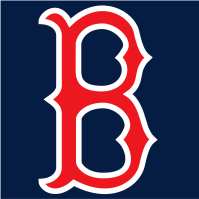
The Boston Red Sox are a Major League Baseball (MLB) team based in Boston, Massachusetts. From 1912 to the present, the Red Sox have played in Fenway Park. The "Red Sox" name originates from the iconic uniform feature. They are sometimes nicknamed the "BoSox", a combination of "Boston" and "Sox" (as opposed to the "ChiSox"), the "Crimson Hose", and "the Olde Towne Team". Most fans simply refer to them as the Sox.
One of the American League's eight charter franchises, the club was founded in Boston in 1901. They were a dominant team in the early 20th century, defeating the Pittsburgh Pirates in the first World Series in 1903. They won four more championships by 1918, and then went into one of the longest championship droughts in baseball history. Many attributed the phenomenon to the "Curse of the Bambino" said to have been caused by the trade of Babe Ruth to the New York Yankees in 1920. The drought was ended and the "curse" reversed in 2004, when the team won their sixth World Series championship. Championships in 2007 and 2013 followed. Every home game from May 15, 2003, through April 10, 2013, was sold out—a span of 820 games over nearly ten years. The team most recently won the World Series in 2018, the ninth championship in franchise history. (Full article...) -
Image 7

Bob Jamison, announcer from 1979 to 1990, won the Southern League Broadcaster of the Year Award in 1980 and 1982.
The Nashville Sounds Minor League Baseball team has played in Nashville, Tennessee, since being established in 1978 as an expansion team of the Double-A Southern League. They moved up to Triple-A in 1985 as members of the American Association before joining the Pacific Coast League in 1998. In 2021, they were placed in the Triple-A East, which became the International League in 2022. The team has employed seven play-by-play announcers who have provided running commentary for their games' radio broadcasts on fourteen radio stations throughout their history.
As of 2024, all Sounds home and road games are broadcast on WBUZ-HD3 94.9 FM (AM 830). Live audio broadcasts are also available online through the team's website and the MiLB First Pitch app. Games can be viewed through the MiLB.TV subscription feature of the official website of Minor League Baseball, with audio provided by a radio simulcast. (Full article...) -
Image 8
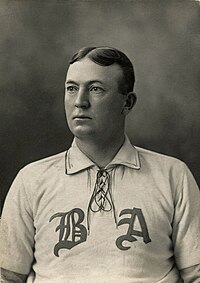
Cy Young is the all-time leader in wins.
In Major League Baseball, the 300-win club is the group of pitchers who have won 300 or more games. Twenty-four pitchers have reached this milestone. This list does not include Bobby Mathews who won 297 in the major leagues plus several more in 1869 and 1870 before the major leagues were established in 1871. The San Francisco Giants are the only franchise to see four players reach 300 wins while on their roster: Tim Keefe in the Players' League, Christy Mathewson and Mickey Welch while the team was in New York, and most recently Randy Johnson. Early in the history of professional baseball, many of the rules favored the pitcher over the batter; the distance pitchers threw to home plate was shorter than today, and pitchers were able to use foreign substances to alter the direction of the ball. Moreover, a schedule with rest days after most games allowed pitchers to start a far higher proportion of their team's games than modern pitchers do, typically every other game or even more (in the second half of the 1884 season Old Hoss Radbourn started 40 games out of 43). The first player to win 300 games was Pud Galvin in 1888. Seven pitchers recorded all or the majority of their career wins in the 19th century: Galvin, Cy Young, Kid Nichols, Keefe, John Clarkson, Charles Radbourn, and Welch. Four more pitchers joined the club in the first quarter of the 20th century: Mathewson, Walter Johnson, Eddie Plank, and Grover Cleveland Alexander. Young is the all-time leader in wins with 511, a mark that is considered unbreakable. If a modern-day pitcher won 20 games per season for 25 seasons, he would still be 11 games short of Young's mark.
Only three pitchers—Lefty Grove, Warren Spahn, and Early Wynn—joined the 300-win club between 1924 and 1982, which may be explained by a number of factors: the abolition of the spitball; World War II military service, such as Bob Feller's; and the growing importance of the home run in the game. As the home run became commonplace, the physical and mental demands on pitchers dramatically increased, which led to the use of a four-man starting rotation. Between 1982 and 1990, the 300-win club gained six members: Gaylord Perry, Phil Niekro, Steve Carlton, Nolan Ryan, Don Sutton, and Tom Seaver. These pitchers benefited from baseball's increase from a 154-game schedule to a 162-game schedule in 1961, and expansion of the league from 16 teams in 1960 to 26 by 1977. The increased use of specialized relief pitchers, an expanded strike zone, and new stadiums, including Shea Stadium, Dodger Stadium and the Astrodome, that were pitcher's parks all also suppressed offensive production. Also, the increasing sophistication of training methods and sports medicine - such as Tommy John surgery - allowed players to maintain a high competitive level for a longer time. Randy Johnson, for example, won more games in his 40s than he did in his 20s. (Full article...) -
Image 9

1891 Athletics manager Bill Sharsig
The Philadelphia Athletics were a professional baseball team that existed for two seasons from 1890 to 1891. Known alternatively as the Philadelphia Quakers, and sometimes informally as "Buffinton's Beauties", they played their first season in the newly created Players' League (PL) of 1890, and were managed by Jim Fogarty and Charlie Buffinton. After the demise of the PL following the 1890 season, the team joined the American Association (AA) for the 1891 season, and were managed by Bill Sharsig and George Wood. For each season, the franchise used Forepaugh Park as their home field.
Despite the existence of established major league representation in Philadelphia, the Phillies of the National League (NL) and the Athletics of the AA, the new PL franchise was able to sign veteran players, including Buffinton, Billy Shindle, George Wood, and Ben Sanders. The Quakers finished the season with a 68–63 win–loss record, with one tie, placing them fifth among the eight PL teams. (Full article...) -
Image 10Roberto Alomar's 1994 Gold Glove Award
The Rawlings Gold Glove Award, usually referred to as simply the Gold Glove, is the award given annually to the Major League Baseball (MLB) players judged to have exhibited superior individual fielding performances at each fielding position in both the National League (NL) and the American League (AL). The Gold Glove is widely considered one of the most prestigious defensive awards in baseball.
Winners for position awards are determined from voting by the managers and coaches in each league, who are not permitted to vote for their own players. Additionally, a sabermetric component provided by the Society for American Baseball Research (SABR) accounts for about 25 percent of the vote. For the utility player awards, the sabermetric component and other defensive statistics are exclusively used to select the winners, without any voting by coaches. (Full article...) -
Image 11

Tony Mullane made five Opening Day starts for the Reds during the 1800s.
The Cincinnati Reds are a Major League Baseball franchise based in Cincinnati who play in the National League's Central Division. In their history, the franchise also played under the names Cincinnati Red Stockings and Cincinnati Redlegs. They played in the American Association from 1882 through 1889, and have played in the National League since 1890. The first game of the new baseball season for a team is played on Opening Day, and being named the Opening Day starter is an honor that is often given to the player who is expected to lead the pitching staff that season, though there are various strategic reasons why a team's best pitcher might not start on Opening Day. The Reds have used 76 Opening Day starting pitchers since they began play as a Major League team in 1882.
The Reds have played in several different home ball parks. They played two seasons in their first home ball park, Bank Street Grounds, and had one win and one loss in Opening Day games there. The team had a record of six wins and ten losses in Opening Day games at League Park, and a record of three wins and seven losses in Opening Day games at the Palace of the Fans. The Reds played in Crosley Field from 1912 through the middle of the 1970 season, and had a record of 27 wins and 31 losses in Opening Day games there. They had an Opening Day record of 19 wins, 11 losses and 1 tie from 1971 through 2002 at Riverfront Stadium, and they have a record of three wins and six losses in Opening Day games at their current home ball park, the Great American Ball Park. That gives the Reds an overall Opening Day record of 59 wins, 66 losses and one tie at home. They have a record of three wins and one loss in Opening Day games on the road. (Full article...) -
Image 12First-round selections Ken Griffey Jr. (top left), Mike Harkey (top right), Jack McDowell (bottom left), and Mike Remlinger (bottom right).
The 1987 Major League Baseball draft is the process by which Major League Baseball (MLB) teams select athletes to play for their organization. High school seniors, college juniors and seniors, and anyone who had never played under a professional contract were considered eligible for the draft. The 1987 MLB Draft took place as a conference call to the Commissioner of Baseball's office in New York from June 2–4. As opposed to the National Football League Draft which appeared on ESPN, no network aired the MLB Draft.
The American League (AL) and the National League (NL) alternated picks throughout the first round; because an NL team drafted first in the 1986 MLB Draft, an AL team had the first selection in 1987. Having finished 67–95 in 1986, the Seattle Mariners had the worst record in the AL and thus obtained the first overall selection. The second selection went to the Pittsburgh Pirates, who had the worst record in the NL. (Full article...) -
Image 13The Toronto Blue Jays are members of the American League (AL) East Division in Major League Baseball (MLB). There have been 14 different managers of the Blue Jays, the only Canadian baseball franchise in Major League Baseball. In baseball, the head coach of a team is called the manager (or more formally, the field manager). They are the only team outside the United States to win a World Series, and the first team to win a World Series in Canada. John Schneider was the interim manager, until the club named him their full time manager in the off season and giving him a three-year contract after, replacing Charlie Montoyo; Montoyo was fired on July 13, 2022.
Cito Gaston has both managed and won the most games of any Blue Jays manager, with 1,731 games and 894 wins. He is followed by John Gibbons in both categories, with 1,258 games and 644 wins, who surpassed Bobby Cox's marks during his second stint as manager. Gaston is the only Blue Jays manager to win a World Series in 1992 and 1993, the fourth African-American manager in MLB history, and was the first African-American manager to win a World Series. Cox is the only Blue Jays manager to be awarded the AL Manager of the Year Award in 1985. Mel Queen has the best winning percentage by winning 80 percent of his 5 games coached. (Full article...) -
Image 14
The Chicago White Sox celebrate after defeating the Minnesota Twins 1–0 to win the 2008 American League Central.
A tie-breaker was required in Major League Baseball (MLB) when two or more teams were tied at the end of the regular season for a postseason position such as a league pennant (prior to the introduction of the League Championship Series in 1969), a division title, or a wild card spot. Until 2022, both the American League (AL) and the National League (NL) used a one-game playoff format for tie-breakers, although the NL used a best-of-three series prior to 1969, when the leagues were split into divisions. As these tie-breaker games counted as part of the regular season and MLB teams (American League beginning in 1961, and National League beginning in 1962) have 162-game regular season schedules, the tie-breaker games were sometimes referred to as "Game 163". In 2022, as part of the new Collective Bargaining Agreement to end the 2021–22 Major League Baseball lockout, tiebreaker games were replaced with statistical tiebreaker procedures.
Sixteen tie-breakers – 12 single-game and four series – have been played in MLB history. In baseball statistics, tie-breaker games counted as regular season games with all events in them counted towards regular season statistics. This had implications on statistical races, such as when Matt Holliday won the batting average and runs batted in titles thanks in part to his performance in the 2007 tie-breaker. Home-field advantage for tie-breakers was determined by a coin flip through the 2008 season, after which performance-based criteria, starting with head-to-head record of the tied teams, were put in place. (Full article...) -
Image 15The 1971 Cy Young Award won by Ferguson Jenkins, on display in the Canadian Baseball Hall of Fame
The Cy Young Award is given annually to the best pitchers in Major League Baseball (MLB), one each for the American League (AL) and National League (NL). The award was introduced in 1956 by Baseball Commissioner Ford C. Frick in honor of Hall of Fame pitcher Cy Young, who died in 1955. The award was originally given to the single best pitcher in the major leagues, but in 1967, after the retirement of Frick, the award was given to one pitcher in each league.
Each league's award is voted on by members of the Baseball Writers' Association of America (BBWAA). Local BBWAA chapter chairmen in each MLB city recommend two writers to vote for each award. Final approval comes from the BBWAA national secretrary-treasurer. Writers vote for either the American League or National League awards, depending on the league in which their local team plays. A total of 30 writers vote for each league's awards. Writers cast their votes prior to the start of postseason play. (Full article...)
More did you know
- ... that brothers George Wright and Harry Wright both managed the Providence Grays National League baseball team?
- ... that Mike Cather earned his first major-league win in an 11-inning Atlanta Braves’ win, the same night the Braves earned the National League Eastern Division title?
- ... that in 1975, his only full season, Stan Perzanowski's earned run average was the lowest on the Texas Rangers?
- ... that Josh Gibson Field in Pittsburgh, Pennsylvania, is named for Negro League star Josh Gibson, who has been called the "black Babe Ruth?"
- ... that Ryota Igarashi used to hold the Nippon Professional Baseball record for the fastest pitch thrown?
Sports portals
Selected picture

| Credit: Unknown, probably Matthew Brady or Levin Corbin Handy |
Abner Doubleday (June 26, 1819 – January 26, 1893) was a career United States Army officer and Union general in the American Civil War. He fired the first shot in defense of Fort Sumter, the opening battle of the war, and had a pivotal role in the early fighting at the Battle of Gettysburg. Gettysburg was his finest hour, but his relief by Maj. Gen. George G. Meade caused lasting enmity between the two men. In addition, he is known for a popular legend that he invented baseball, which has been debunked by almost all sports historians.
Associated Wikimedia
The following Wikimedia Foundation sister projects provide more on this subject:
-
Commons
Free media repository -
Wikibooks
Free textbooks and manuals -
Wikidata
Free knowledge base -
Wikinews
Free-content news -
Wikiquote
Collection of quotations -
Wikisource
Free-content library -
Wikiversity
Free learning tools -
Wiktionary
Dictionary and thesaurus
More portals
- Portals with triaged subpages from June 2018
- All portals with triaged subpages
- Portals with no named maintainer
- Automated article-slideshow portals with 51–100 articles in article list
- Automated article-slideshow portals with 501–1000 articles in article list
- Random portal component with 41–50 available subpages
- Automated article-slideshow portals with 201–500 articles in article list
- Random portal component with 11–15 available subpages
- Random portal component with 21–25 available image subpages







